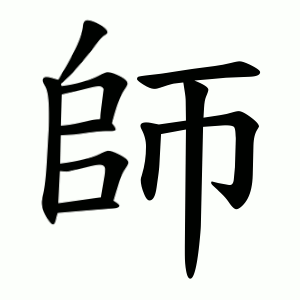師
- teacher, master, guide;
- army, troops;
Etymology
Compound ideograph:
帀 (to surround, encircle) – semantic, representing a surrounding or organized group.
阜 (mound, hill; by extension, crowd, assembly) – semantic, indicating a mass of people or gathering.
Together, the form depicts an organized group of people or followers, later extended to mean “army” and “one who leads or teaches such a group.” From this sense of guidance and leadership came the meaning “teacher, master.”
Semantic range:
- teacher, mentor, master;
- military force, army, troops;
- official, functionary;
- by extension, an expert in a field.
Usage in Korean
교사 (敎師) — teacher, instructor
의사 (醫師) — doctor, physician (lit. “medical master”)
법사 (法師) — Buddhist priest, Dharma master
대군사 (大軍師) — great military strategist
군사 (軍師) — military adviser, strategist
석사 (碩士) — master’s degree; learned person
Words that derived from 師
Additional notes
In Buddhist tradition, 師 is deeply tied to the notion of a spiritual guide. It appears in titles such as 법사 (法師, Dharma Master), 선사 (禪師, Zen Master), and 대선사 (大禪師, Great Zen Master), where it designates not merely an instructor but one who embodies and transmits Dharma. The term emphasizes the guiding role of a teacher on the path of practice, carrying connotations of reverence and spiritual authority.
- 竹口一中月 (HRMLB)
- ⿰ 𠂤 帀
